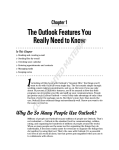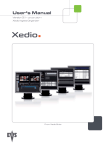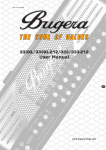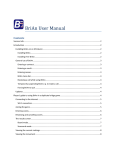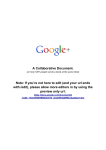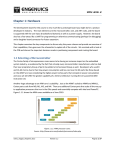Download Wiley Outlook 2007 For Dummies
Transcript
Chapter 1 RI AL Fundamental Features: How Did You Ever Do without Outlook? TE In This Chapter Reading and creating e-mail MA Sending files by e-mail Entering appointments and contacts Checking your calendar D Entering tasks TE Taking notes GH O CO PY RI utlook is easier to use than you might think; it also does a lot more than you might realize. Even if you use only about 10 percent of Outlook’s features, you’ll be amazed at how this little program can streamline your life and spiff up your communications. People get pretty excited about Outlook — even if they take advantage of only a tiny fraction of what the package can do. I’m kicking off this book with “Outlook’s Greatest Hits,” the things you’ll want to do with Outlook every single day. The list sounds simple enough: sending e-mail, making appointments, and so on. But there’s more here than meets the eye; Outlook does ordinary things extraordinarily well. I know you want to do the same, so read on. Easy Ways to Do Anything in Outlook Well, okay, maybe you can’t use Outlook to decipher hieroglyphics — but if you learn a little about some basic techniques, you can do a lot in Outlook — click an icon to do something, view something, or complete something. Using Outlook is so simple, I can sum it up in just a few how-to sentences to cover the most common tasks: 12 Part I: Getting the Competitive Edge with Outlook Open an item and read it: Double-click the item. Create a new item: Click an icon in the Navigation Pane, click the New button in the toolbar at the top of the screen, and fill out the form that appears. When you’re done, click the button labeled Send — or, alternatively, Save and Close. Delete an item: Click the item once to select it, and then click the Delete icon in the toolbar at the top of the screen. The Delete icon contains a black X. Move an item: Use your mouse to drag the item to where you want it. Does that seem too simple? No problem. If you have an itch to complicate things, you could try to use Outlook while hopping on a pogo stick or flying the space shuttle. But why? These four tricks can take you a long way. Outlook can also do some sophisticated tricks, such as automatically sorting your e-mail or creating automated form letters, but you’ll need to learn a few details to take advantage of those tricks. The other 300 pages of this book cover the finer points of Outlook. If you only wanted the basics, I could’ve sent you a postcard. The pictures you see in this book and the instructions you read assume you’re using Outlook the way it comes out of the box from Microsoft — with all the standard options installed. If you don’t like the way the program looks (or what things are named) when you install Outlook, you can change nearly everything. If you change too much, however, some instructions and examples I give you won’t make sense, because then the parts of the program that I talk about may have names you gave them, rather than the ones Microsoft originally assigned. The Microsoft people generally did a good job of making Outlook easy to use. I suggest leaving the general arrangement alone until you’re comfortable using Outlook. Reading E-Mail E-mail is Outlook’s most popular feature. I’ve run across people who didn’t know Outlook could do anything but exchange e-mail messages. It’s a good thing Outlook makes it so easy to read your e-mail. When you start Outlook, normally you see a screen with three columns. The center column is your list of messages; the right column (called the Reading Pane) contains the text of one of those messages. If the message is short enough, you may see its entire text in the right column, as shown in Figure 1-1. If the message is longer, you’ll have to open it to see the whole thing. Chapter 1: Fundamental Features: How Did You Ever Do without Outlook? Figure 1-1: Double-click the message you want to read. Mail button Reading pane Here’s how to see the entire message: 1. Click the Mail button in the Navigation Pane. You don’t need this step if you can already see the messages, but it doesn’t hurt. 2. Double-click the title of the message. Now you can see the entire message. 3. Press Esc. The message form closes. A quick way to skim the messages in your Inbox is to click a message, then press the up-arrow or down-arrow key on your keyboard. You can move through your message list as you read the text of your messages in the Reading Pane. 13 14 Part I: Getting the Competitive Edge with Outlook If you feel overwhelmed by the number of e-mail messages you get each day, you’re not alone. Billions and billions of e-mail messages fly around the Internet each day, and lots of people are feeling buried in messages. You discover the secrets of sorting and managing your messages in Chapter 6. Answering E-Mail When you open an e-mail message in Outlook to read it, buttons labeled Reply and Reply to All appear at the top of the message screen. That’s a hint. When you want to reply to a message you’re reading, click the Reply button. A new message form opens, already addressed to the person who sent you the message. If you’re reading a message sent to several people besides you, you also have the option of sending a reply to everyone involved by clicking the Reply to All button. When you reply to a message, the text of the message that was sent to you is automatically included. Some people like to include original text in their replies, some don’t. In Chapter 5, I show you how to change what Outlook automatically includes in replies. Creating New E-Mail Messages At its easiest, the process of creating a new e-mail message in Outlook is ridiculously simple. Even a child can do it. If you can’t get a child to create a new e-mail message for you, you can even do it yourself. To create a new e-mail message, follow these steps: 1. Click the Mail button in the Navigation Pane. Your message list appears. 2. Click the New button in the toolbar. The New Message form appears. 3. Fill out the New Message form. Put the address of your recipient in the To box, a subject in the Subject box, and type a message in the main message box. 4. Click Send. Your message is on its way. If you want to send a plain e-mail message, that’s all you have to do. If you prefer to send a fancy e-mail, Outlook provides the bells and whistles — some of which are actually useful. You might (for example) send a High Chapter 1: Fundamental Features: How Did You Ever Do without Outlook? Priority message to impress some big shots, or send a Confidential message about a hush-hush topic. (Discover the mysteries of confidential e-mail in Chapter 4.) Sending a File Call me crazy, but I suspect you have more to do than exchange e-mail all day. You probably do lots of daily work in programs other than Outlook. You might create documents in Microsoft Word or build elaborate spreadsheets with Excel. When you want to send a file by e-mail, Outlook gets involved, although sometimes it works in the background. To e-mail a document you created in Microsoft Word, for example, follow these steps: 1. Open the document in Microsoft Word. The document appears on-screen. 2. Click the Office icon in the upper-left corner of the screen and choose Send To ➪ Mail Recipient (as attachment). The New Message form appears with your document listed on the Attachment line (as pictured in Figure 1-2). Figure 1-2: You can e-mail a document right from Microsoft Word. 15 16 Part I: Getting the Competitive Edge with Outlook 3. Type the e-mail address of your recipient on the To line. The address you enter appears on the To line. 4. Click Send. Your file is now en route. When you’re just sending one Word file, these steps are the easiest way to go. If you’re sending more than one file, I describe a more powerful way to attach files in Chapter 5. Entering an Appointment If you’ve ever used an old-fashioned paper planner, the Outlook calendar will look familiar to you. When you click the Calendar icon and then click the Day tab, you see a grid in the middle of the screen with lines representing each half hour of the day (as in Figure 1-3). To enter an appointment at a certain time, just click the line next to the time you want your appointment to begin, type a name for your appointment, and press Enter. If you want to enter more detailed information about your appointment — such as ending time, location, category, and so on; see Chapter 8 for the nittygritty about keeping your calendar. Figure 1-3: Track your busy schedule in the Outlook calendar. Chapter 1: Fundamental Features: How Did You Ever Do without Outlook? Checking Your Calendar Time management involves more than just entering appointments. If you’re really busy, you want to manage your time by slicing and dicing your list of appointments to see when you’re free enough to add even more appointments. You can choose from several different views of your calendar by clicking the Day, Week, and Month buttons at the top of the Calendar screen. If you need a more elaborate collection of calendar views, choose one of the views listed in the Current View section of the Navigation Pane. To really master time management, see Chapter 8 to see the different ways you can view your Outlook calendar. Adding a Contact When it’s not what you know but who you know, you need a good tool for keeping track of who’s who. Outlook is a great tool for managing your list of names and addresses, and it’s just as easy to use as your Little Black Book. To enter a new contact, click the Contacts button in the Navigation Pane; then click the New button on the toolbar to open the New Contact entry form. Fill in the blanks on the form (an example appears in Figure 1-4), and then click Save and Close. Presto — you have a Contacts list. Figure 1-4: Keep detailed information about everyone you know in the contacts list. 17 18 Part I: Getting the Competitive Edge with Outlook Outlook does a lot more than your little black book — if you know the ropes. Chapter 7 reveals the secrets of searching, sorting, and grouping the names on your list — and of using e-mail to keep in touch with all the important people in your life. Entering a Task Entering a task in Outlook isn’t much of a task itself. You can click the Task button see a list of your tasks in a flash. If you see the words Type a New Task, you’ve got a clue. To enter a new task, follow these steps: 1. Click the Tasks button in the Navigation Bar. Your list of tasks appears. 2. Click the text that says Type a New Task. The words disappear, and you see the insertion point (a blinking line). 3. Type the name of your task. Your task appears in the block under the Subject line on the Task List (which in turn appears in Figure 1-5). Figure 1-5: Entering your task in the Task list. Chapter 1: Fundamental Features: How Did You Ever Do without Outlook? 4. Press the Enter key. Your new task moves down to the Task List with your other tasks. Outlook can help you manage anything from a simple shopping list to a complex business project. In Chapter 9, I show you how to deal with recurring tasks, how to regenerate tasks, and also how to mark tasks as complete (and earn the right to brag about how much you’ve accomplished). I also show you how to take advantage of a gizmo called the Task Pad to do the job even quicker. Taking Notes I have hundreds of little scraps of information that I need to keep somewhere, but until Outlook came along, I didn’t have a place to put them. Now all the written flotsam and jetsam I’ve decided I need goes into my Outlook notes collection — where I can find it all again when I need it. To create a new note, follow these steps: 1. Click the Notes button in the Navigation Pane (or press Ctrl+5). Your list of notes appears. 2. Click the New button in the toolbar. A blank note appears. 3. Type the text you want to save. The text you type appears in the note (see Figure 1-6). 4. Press Esc. The note you created appears in your list of notes. An even quicker way to enter a note is to press Ctrl+Shift+N and type your note text. You can see how easy it is to amass a large collection of small notes. Chapter 10 tells you everything you need to know about notes, including how to find the notes you’ve saved, as well as how to sort, categorize, and organize your collection of notes and even how to delete the ones you don’t need anymore. After you’re in the habit of using Outlook to organize your life, I’m sure you’ll want to move beyond the basics. That’s what the rest of this book shows you. When you’re ready to share your work with other people, send e-mail like a pro, or just finish your workday by 5:00 p.m. and get home, you’ll find ways to use Outlook to make your job — and your life — easier to manage. 19 20 Part I: Getting the Competitive Edge with Outlook Figure 1-6: Preserve your prose for posterity in an Outlook note.










